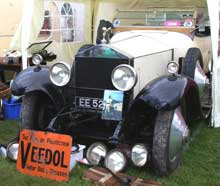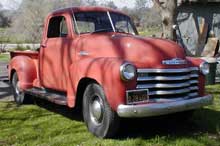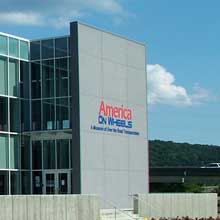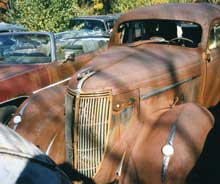Jumbling at Beaulieu
Each automotive event has its place in the season. In Britain in September, all enthusiasts head for Beaulieu to the annual Autojumble. Held on the grounds of the Beaulieu estate in Hampshire, home also to the National Motor Museum, Autojumble was inspired by the gigantic Hershey swap meet, but in four decades has developed its own flavour and character.
The name is credited to Michael Ware, early event organizer and director of the museum, now retired. Since "swap meet" had no context in Britain, Michael suggested combining "auto" with "jumble," the British term for a rummage sale. Autojumble was born in 1967, and this year celebrated its 42nd event on September 13th and 14th.
As at Hershey, one can find all things automotive: sheet metal, seats, bodies, radiators, lighting, automobilia, mascots, signs, model cars, pedal cars both entry level and prestige, even intricate demonstration models like this German chassis. You can even buy new wood for your Morris Traveler. Fanciers of Austin Sevens are especially well catered for. On the grounds they can find engines, chassis, both basic and complete, even a kit to build your own car.
Equivalent to Hershey's Car Corral is the Automart, a large area for selling cars. This year's crop included such treats as a 1929 Essex, E-Type Jaguar and a Wolseley used in the PBS-broadcast series "Foyle's War," though whether it was driven by Honeysuckle Weeks was not noted. What looked like a Durant bore the Rugby badge of the export version, and nowhere else on earth would you be likely to see a clapped-out Austin Cambridge sidled up to a restored Falcon Knight. Also in the Automart were two cars by custom virtuoso Andy Saunders, the Lancia-based Zero and All-Ego, an Austin Allegro converted in three days for the British television programme "Juice My Lemon." Both, plus nine other Saunders cars, will be offered in RM's London sale on October 29th.
Each year Bonhams holds an auction on the Autojumble grounds. This year's sale included restorable examples of Aston-Martin, Model N Hupmobile, Sunbeam Harrington LeMans V8 coupe, a rather sad 1931 Lincoln, and a trio of GN cyclecars, the most unassuming of which, a 1922 Vitesse, nearly doubled its pre-sale estimate. A work-in-progress, the 1910 Hudson Model 20, went for £14,800 (about $26,490 at time of sale). Bargain of the sale was a ready-to-drive 1948 P3 Rover, which sold for £2,200 ($3,940). Auctioneer James Knight coaxed a top bid of £155,000 ($277,450) for the Brighton-eligible 1905 Renault, not enough to satisfy the vendor, while a 1940 Chevy convertible was knocked down for £40,000 ($71,600). Buyer's premiums were added to all successful bids.
Autojumble is home to many club stands and on the grounds one sees interesting contraptions like the one-passenger French-built Mini-Comtesse. There are occasional side shows, like a Curtiss OX-5 aero engine that gave live demos throughout the weekend. At 2,200 spaces, Beaulieu is but a shadow of Hershey, but covering it all in two days can still be exhausting. A feature not found at Hershey is the ability to leave large parts at a central depot and have them transported, free, to one's car at the end of the day. Although the organizers put metal roadways in high traffic areas, wet weather this summer left some areas a bit muddy. By show's end, a few vendors had to be extricated Hershey-style.
Next year's Autojumble will be September 12th-13th. It's not too early to start making travel plans.




